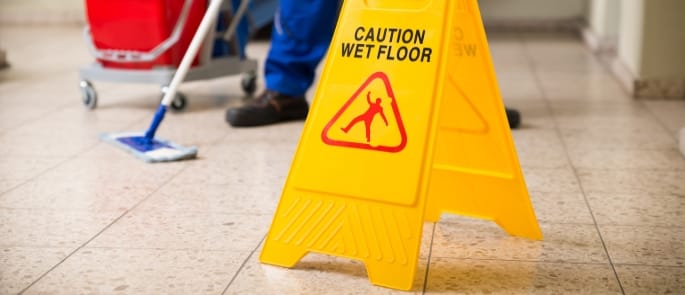Statistically speaking, an office is a relatively safe place to work. You’re many more times likely to sustain a serious injury while working on a farm or a construction site than you are while sitting at a desk. But that isn’t to say that it’s impossible to suffer a workplace accident in an office. In fact, because the injuries you sustain while sitting can be so subtle and insidious, they’re actually more likely to be overlooked and ignored.
In the long run, workplace injury and illness can be a serious drain on productivity. Employers should therefore take steps to identify and eliminate the potential causes of accidents, before those accidents actually happen.
Let’s take a look at a few of the more common kinds of accident and how they can be avoided.
Slips, Trips and Falls
An office is an environment that’s easily cluttered. Trailing cables, slippery wet floors, and boxes can all cause an injury if they’re left in a place where someone is likely to walk. The easiest way to deal with this particular problem is to make sure that everyone’s aware of it, and to develop a culture where leaving hazards around is not accepted, even if those hazards don’t necessarily cause an accident.
Electrical Accidents
If you’re working in an office, then you’re going to be using electricity. We’ve already mentioned the cables that carry electricity, and the threat they can pose as a tripping hazard. But what about the electricity itself? The solution here is to make sure that your electrical systems are competently installed, and maintained pro-actively. Staff who aren’t competent shouldn’t be expected to care for electrical systems.
Incorrect Handling
If your office is dealing with huge amounts of paper, then it will need to contend with an additional level of clutter. This not only creates a more chaotic working environment – it also means a greater likelihood of strains and muscular injuries among office workers who attempt to pick up and carry those files. Outsourcing payroll management and other administrative activities will help to lessen the burden on your office staff.
Eye Strain
Office staff are expected to spend most of their lives staring at monitors. Eye strain is therefore an occupational hazard. Setting up the display in such a way that it’s easily visible without squinting is critical. Make sure that the brightness is minimal – you’ll not only reduce your energy expenditure, but reduce headaches, too.
Modern operating systems come with a range of options for people with poor visibility – which, to a certain extent, is most of us. Make sure that staff are trained to the extent that they can easily adjust their displays. For example, Windows users can hold the Windows key while pressing plus or minus to easily use the magnifier.
Ergonomics
Everyone’s desk should be set up with optimal ergonomics in mind. That means straight spines, no slumping, and regular breaks to avoid repetitive strain injuries. With the right ergonomic setup, you can vastly improve the productivity in a given workspace.







